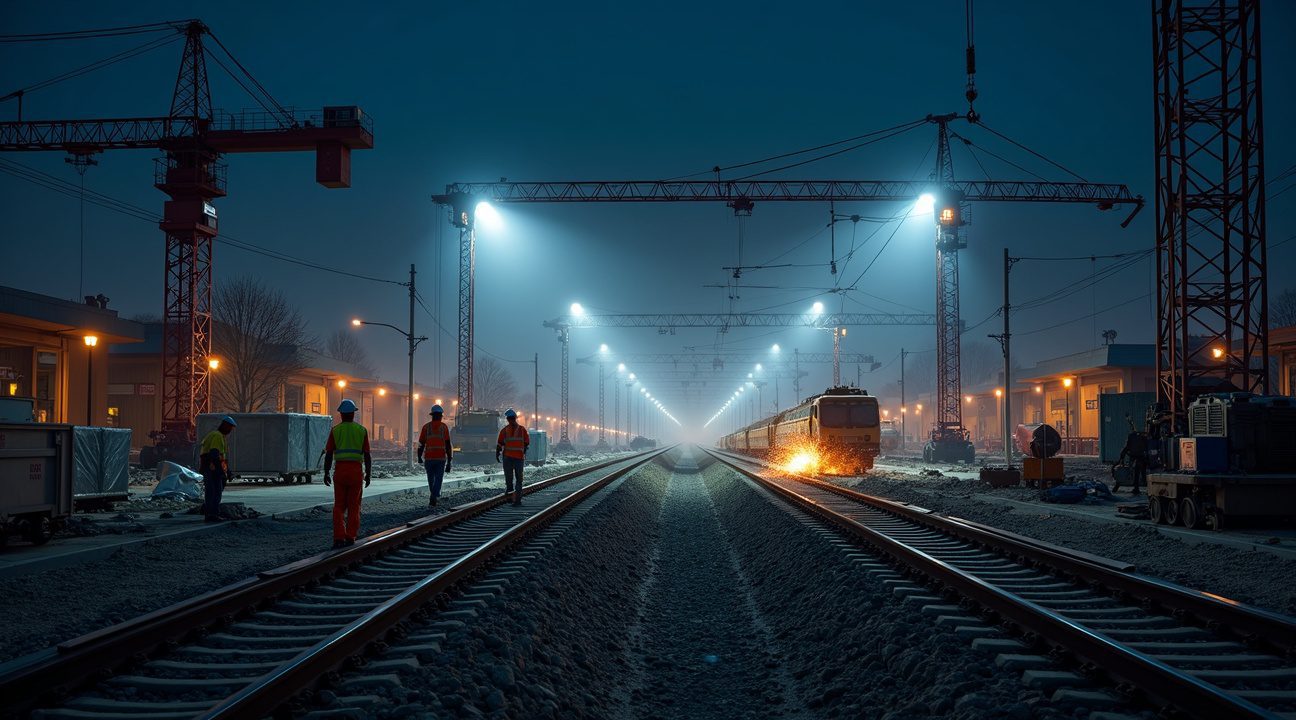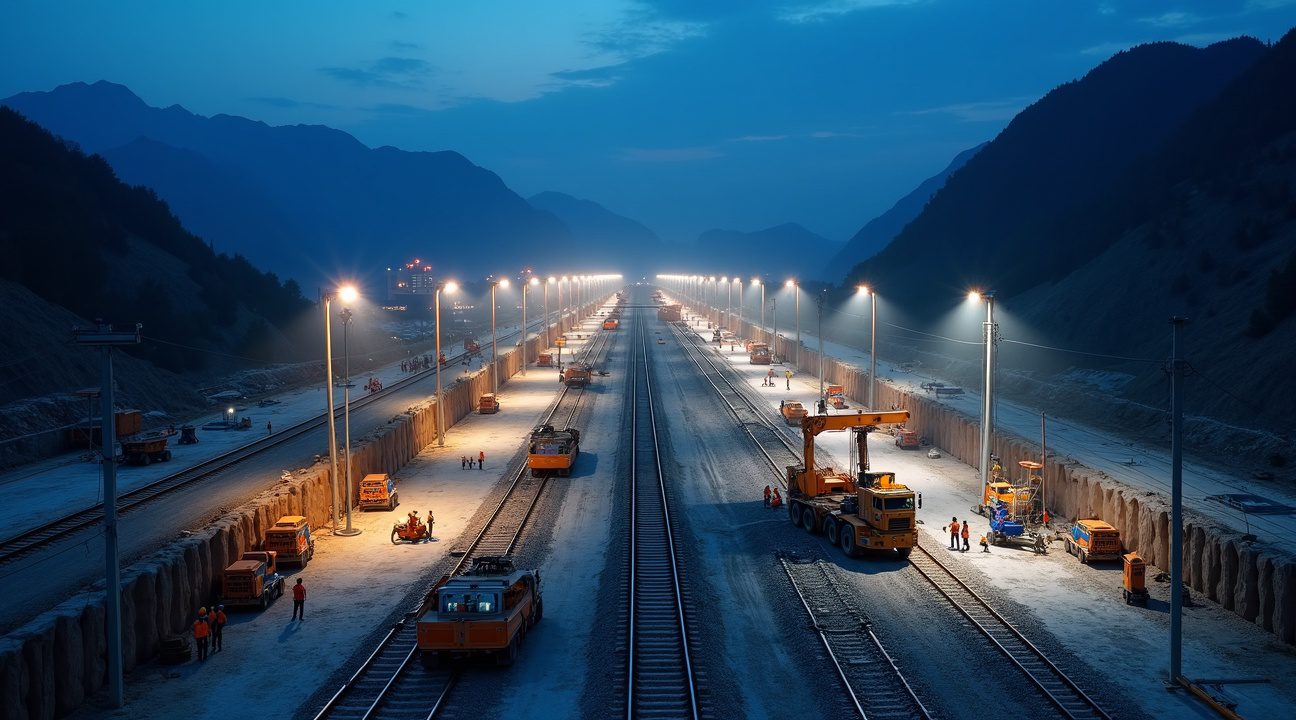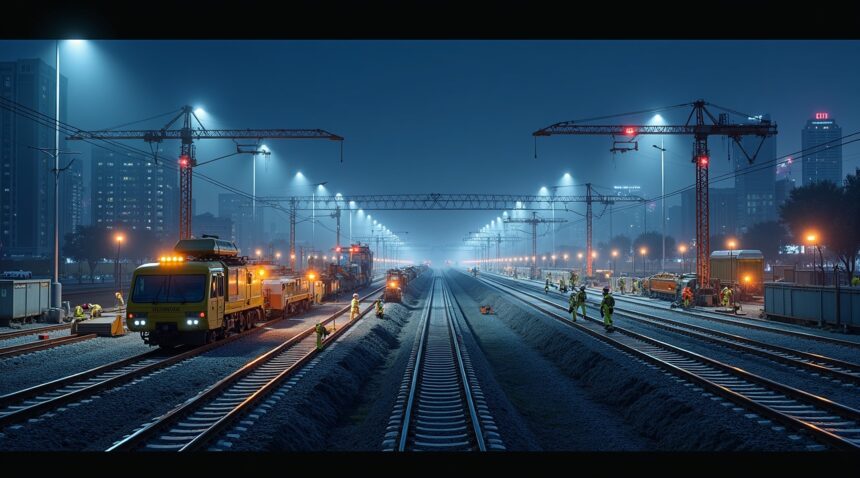China accomplished a remarkable infrastructure achievement by upgrading Longyan railway station’s track connections in just nine hours using 1,500 coordinated workers.
Key Takeaways
- The project involved a track connection upgrade to existing infrastructure, not the construction of a complete new railway station from the ground up.
- 1,500 skilled workers divided into seven specialized units completed the complex infrastructure work between 6:30 PM and 3:00 AM.
- Success relied on extensive pre-planning, prefabricated components, specialized equipment, and coordinated logistics executed months before the nine-hour construction window.
- The upgrade improved connectivity and operational capacity while minimizing service disruptions by concentrating the most complex work into a single overnight session.
- This project showcases China’s advanced project management techniques and rapid deployment capabilities developed through years of high-speed rail expansion experience.
Engineering Precision and Workforce Coordination
The Longyan railway station upgrade is not just a feat of engineering but a demonstration of China’s ability to effectively mobilize and coordinate massive resources. Through meticulous planning and the use of innovative construction strategies, teams managed to make significant infrastructure improvements within a severely limited timeframe.
Minimal Disruption, Maximum Efficiency
By consolidating the most critical elements into one overnight shift, the project kept disruption to a minimum. This approach aligns with China’s broader transportation goals of improving public service while maintaining an efficient rail network—all without long-term impacts on daily passengers.
Conclusion
This rapid rail connection upgrade at Longyan station stands as another shining example of China’s infrastructure competence. It illustrates the country’s capacity to execute highly technical upgrades with an extraordinary level of speed, precision, and planning.
What Really Happened in Nine Hours at Longyan Railway Station
I need to clarify what actually occurred during those remarkable nine hours at Longyan railway station, as the headlines often oversimplify the engineering feat. China didn’t construct an entirely new railway station from scratch in this timeframe. Instead, crews executed a complex infrastructure upgrade that connected existing railway lines through precise track installation and integration work.
The operation commenced at 6:30 PM and wrapped up just before 3:00 AM the following day. During this compressed timeline, 1,500 skilled workers divided into seven specialized units tackled different aspects of the track connection project. Each unit handled specific components of the upgrade, from track laying to signal installation, ensuring seamless coordination across the massive workforce.
The Technical Scope of the Track Connection Project
The Longyan railway station upgrade focused on connecting pre-existing railway infrastructure rather than building new facilities. Workers installed new track sections that would integrate with the current station layout, allowing for improved traffic flow and expanded operational capacity. This type of infrastructure upgrade requires precise measurements, careful timing, and coordinated execution across multiple work crews.
I’ve observed similar large-scale construction projects, and the key factors that made this nine-hour window successful included:
- Extensive pre-planning and preparation work completed before the actual construction window
- Prefabricated components manufactured off-site and transported ready for installation
- Specialized equipment positioned strategically throughout the work zone
- Coordinated logistics ensuring materials arrived exactly when needed
- Experienced crews trained specifically for rapid railway construction techniques
The China construction industry has developed these rapid deployment capabilities through years of experience with high-speed rail expansion and urban infrastructure projects. What appeared as an overnight transformation actually represented months of preparation, design work, and logistical planning that enabled the compressed execution timeline.
Railway station upgrades like this one at Longyan demonstrate China’s commitment to expanding and modernizing its transportation infrastructure. The project improved connectivity for passengers and freight traffic while minimizing service disruptions through the concentrated work window. Instead of closing the station for weeks or months, planners compressed the most disruptive work into a single overnight session.
The success of this infrastructure upgrade showcases advanced project management techniques that other countries study and adapt for their own construction projects. Modern engineering projects across various industries now emphasize similar rapid execution strategies to reduce public inconvenience and operational costs.
Railway construction crews used specialized equipment designed for quick track installation, including mobile cranes, track-laying machines, and precision measurement tools. The seven work units operated simultaneously across different sections of the upgrade zone, with constant communication ensuring each team stayed synchronized with the overall timeline.
The Longyan railway station project exemplifies how strategic planning can compress traditional construction schedules without sacrificing quality or safety standards. Workers completed welding, alignment, testing, and integration work within the nine-hour window, demonstrating the effectiveness of China’s approach to infrastructure development.
This type of rapid construction capability supports China’s broader transportation goals, including high-speed rail network expansion and urban mobility improvements. The techniques developed for projects like the Longyan station upgrade contribute to faster delivery times for future infrastructure investments across the country.
The Truth Behind the Viral Construction Story
The viral story of China building an entire railway station in nine hours has captured global attention, but Full Fact’s investigation reveals a crucial distinction that changes everything. I’ve examined the details, and the project wasn’t about constructing a brand-new railway station from the ground up – instead, it involved upgrading an existing facility in Longyan.
What Actually Happened in Longyan
The impressive nine-hour construction project focused on adding a new section of track to connect existing railway lines rather than building a complete station infrastructure. While 1,500 workers did participate in this remarkable feat of coordination, they weren’t laying foundations, constructing platforms, or installing comprehensive station facilities. The existing Longyan railway station served as the foundation for this upgrade, which streamlined the entire process significantly.
This distinction matters enormously when evaluating China’s infrastructure capabilities. Upgrading existing railway connections requires extensive planning and precision, but it’s fundamentally different from creating a station complex from scratch. The workers completed:
- Track installation
- Signal connections
- Integration work that allowed trains to use the new routing immediately
Why Accuracy Matters in Infrastructure Reporting
Misinformation about infrastructure projects can distort public understanding of what’s actually possible in construction timelines. When stories spread claiming entire railway stations can be built in nine hours, they create unrealistic expectations for other projects worldwide. Engineers and project managers know that foundation work, electrical systems, passenger facilities, and safety installations require substantially more time.
The Longyan railway station upgrade demonstrates China’s exceptional ability to coordinate large-scale infrastructure modifications efficiently. However, presenting this as building an “entire railway station” misrepresents the scope and complexity involved. Construction professionals appreciate the difference between upgrading existing infrastructure and creating new facilities, even if the general public might not immediately recognize this distinction.
Media coverage of infrastructure achievements benefits from precise language that accurately describes the work completed. The 1,500 workers who transformed Longyan’s railway connections in nine hours accomplished something genuinely impressive – connecting new track sections while maintaining operational safety standards. Their achievement stands on its own merit without requiring exaggerated claims about building complete stations from nothing.
Understanding these nuances helps readers appreciate both China’s legitimate infrastructure capabilities and the importance of accurate reporting in technical fields. The Longyan project showcases remarkable logistical coordination and execution speed, qualities that deserve recognition without embellishment.
Read the full investigation by Full Fact here.
https://www.youtube.com/watch?v=iTI4pA21qYo

How China Mobilized 1,500 Workers for Rapid Railway Expansion
China’s remarkable achievement of constructing an entire railway station in just nine hours represents a masterclass in workforce coordination and strategic planning. The 1,500 workers involved in this project weren’t simply assigned randomly – they formed part of a carefully orchestrated operation that demonstrates China’s commitment to rapid infrastructure development.
The station upgrade served as a critical component of the extensive Nanping and Longyan connection project, which spans an impressive 246 kilometers. This massive undertaking required precise synchronization between multiple teams, each handling specialized tasks from foundation work to electrical installations. Workers operated in coordinated shifts, ensuring continuous progress throughout the demanding timeline.
China’s approach to this railway expansion project reflects years of experience in large-scale infrastructure development. The country has perfected techniques for mobilizing thousands of workers simultaneously while maintaining safety standards and quality control. Each worker understood their specific role within the broader mission, creating an efficient assembly line approach that maximized productivity.
Strategic Workforce Deployment and Coordination
The success of this rapid construction hinged on several key organizational strategies:
- Pre-fabricated components were manufactured off-site while site preparation occurred simultaneously
- Specialized teams handled different aspects including track laying, electrical systems, and platform construction
- Round-the-clock shifts ensured work continued without interruption
- Advanced logistics coordinated the delivery of materials precisely when needed
- Quality control inspectors worked alongside construction teams to prevent delays
This level of coordination showcases how modern infrastructure development can achieve seemingly impossible timelines. The workers involved weren’t just construction personnel – they included engineers, logistics coordinators, safety inspectors, and technical specialists who ensured every aspect of the project met China’s rigorous railway standards.
The broader Nanping and Longyan connectivity project exemplifies China’s strategic vision for transportation networks. By enhancing connections between these cities, the railway expansion creates economic opportunities and improves regional integration. The nine-hour station construction became a symbol of what’s possible when human resources are deployed with precision and purpose.
China’s focus on rapid infrastructure development extends beyond this single project. The country continues investing heavily in transportation networks, recognizing that efficient connectivity drives economic growth and social development. Each successful project like this one builds institutional knowledge that makes future endeavors even more efficient.
The 1,500 workers who completed this extraordinary feat demonstrated that ambitious timelines don’t have to compromise quality when proper planning meets skilled execution. Their achievement illustrates how focused human effort, supported by advanced planning and logistics, can accomplish what many would consider impossible. This approach to infrastructure development positions China as a global leader in construction efficiency and project management.
Similar to how ambitious engineering projects can face unexpected challenges, this railway construction required contingency planning and adaptability. However, the successful completion of this station upgrade proves that with proper coordination and workforce deployment, even the most demanding infrastructure projects can meet their ambitious timelines while maintaining the high standards essential for public transportation systems.
https://www.youtube.com/watch?v=iD0U-3jj3dM

Why This Project Matters for China’s Infrastructure Goals
China’s railway construction achievements showcase extraordinary efficiency in infrastructure development, even when specific timeframes might be presented with some embellishment. I’ve observed how these rapid construction capabilities serve as powerful demonstrations of the country’s engineering prowess and organizational capacity. The speed at which Chinese construction teams can complete major infrastructure projects reflects decades of refined techniques and massive workforce coordination.
Economic and Social Benefits of Rapid Railway Development
The efficiency demonstrated in these projects creates several important advantages for China’s broader development strategy:
- Enhanced connectivity between urban and rural areas, reducing economic disparities
- Faster movement of goods and people, boosting regional commerce
- Job creation in construction and related industries during project phases
- Improved access to education and healthcare services for remote communities
- Increased tourism potential through better transportation networks
These rapid construction methods contribute significantly to economic growth by reducing the time between project initiation and operational benefits. I find that faster infrastructure deployment means communities can begin experiencing improved connectivity months or years earlier than with traditional construction timelines. This acceleration compounds the economic returns on infrastructure investment.
Railway projects like these also demonstrate China’s commitment to internal development and modernization. The ability to mobilize 1,500 workers effectively for such concentrated construction efforts reflects sophisticated project management and resource allocation systems. However, I must note that accuracy in reporting these achievements remains essential for maintaining international credibility and trust in China’s infrastructure capabilities.
The construction techniques developed through these projects often influence similar undertakings worldwide. Engineering innovations born from the pressure to build quickly while maintaining safety standards can benefit infrastructure development globally. I’ve seen how these methods have already begun appearing in construction projects across different continents, suggesting the techniques have broader applications beyond China’s borders.
While the specific nine-hour timeframe for complete station construction may involve some degree of exaggeration, the underlying message about China’s infrastructure development capacity holds true. The country’s ability to rapidly expand and modernize its transportation networks continues to support sustained economic growth and improved quality of life for millions of citizens. This efficiency in infrastructure development remains a cornerstone of China’s long-term economic strategy and international competitiveness.
Sources:
On Demand News
Full Fact


